From the February 2017 issue of GCM magazine:
Invasion of the green stinkworms: Managing Amynthas hupeiensis on
greens
An Asian earthworm could become quite a nuisance on golf courses.
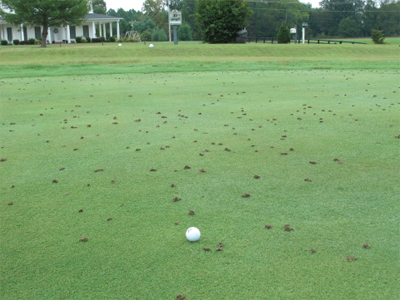
|
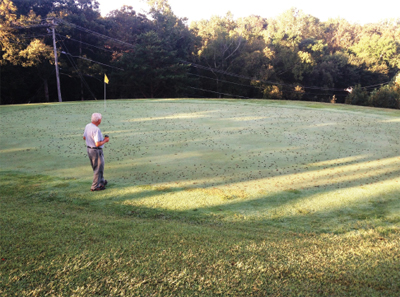
|
|
Figure 1. Top: This sand-based green with Amynthas hupeiensis casts was used for monthly cast counts and sampling of the earthworm’s life stages. Bottom: Affected greens are often covered with A. hupeiensis casts after a summer rain.
Photos by Daniel A. Potter
|
Daniel A. Potter, Ph.D., Carl T. Redmond, Ph.D., and Abiya Saeed, M.S.
Read this story in GCM's digital edition
Long considered a gardener’s friend, earthworms, especially the common topsoil-dwelling Aporrectodea species of European origin, are beneficial in most settings because their activities loosen, aerate and enrich the soil. But not all earthworms are the same. Amynthas hupeiensis, known by such colloquial names as “green stinkworm,” “green riverworm” or “Oriental earthworm,” is an invasive East Asian species whose prolific casts (soil-rich piles of fecal matter) disrupted maintenance and playability of golf courses along the U.S. Atlantic seaboard during the 1940s and ’50s (10,11). Those outbreaks were eventually controlled with high rates of now-defunct older pesticides.
The bad news is that A. hupeiensis is back. We discovered it on golf courses in Kentucky in 2012, the first report of its damage to golf courses west of the Appalachians and the first report from golf courses anywhere in the United States in more than 60 years (Figure 1). Since then, we have found it on at least seven central Kentucky golf courses. This article discusses how to diagnose and control A. hupeiensis, and how to avoid inadvertently introducing the pest to your course. A more detailed account of this research was published in Crop, Forage and Turfgrass Management (9).
Amynthas earthworms (Family Megascolecidae) are native to eastern Asia, where they are the main earthworm pests of golf courses in Japan, South Korea, Thailand and other countries throughout the region. They are thought to have been transported to other regions via soil with plants and have been spread through the horticultural trade, and via their use as fishing bait (3).
Amynthas are aggressive invaders. Several species, particularly A. agrestis, have become established in forests of the eastern U.S., where they aggressively break down leaf litter and organic matter, drastically changing the soil composition, robbing tree seedlings of nutrients, and impairing forest regeneration (2,3). Because of Amynthas, some northern hardwood forests that once had a lush understory now have almost no tree seedlings. Once established, Amynthas are impossible to remove from forest environments. These soil sharks can hitchhike in shipments of mulch and in containerized plants from garden centers, and reports of their damage to gardens, mulched beds of ornamental plants and even lawns are increasing (1). While A. hupeiensis does not seem to be as damaging as its cousins in forest and garden settings, it can nevertheless wreak havoc once established on golf courses.
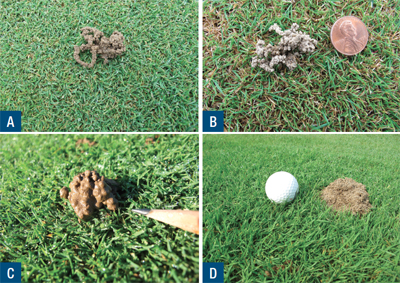 |
|
Figure 2. A, B: Typical Amynthas hupeiensis casts on a sand-based green. Note the sinuate form. C: Smooth casts of a typical topsoil-dwelling earthworm. D: The casts of A. hupeiensis also differ from the volcano- or dome-shaped mounds of fine particulate sandy soil deposited by the turfgrass ant (Lasius neoniger).
|
Casting activity and seasonal development
Amynthas hupeiensis produces large, sandy, often sinuous casts on sand-based greens (Figure 2A,B). The casts differ in appearance from the smaller piles of smooth, muddy aggregates (Figure 2C) deposited by the common, topsoil-dwelling Aporrectodea, which are the predominant earthworms on temperate- and transition-zone golf fairways and sports fields. They also differ from the volcano- or dome-shaped mounds of fine particulate sandy soil deposited around nest entrances of the turfgrass ant, Lasius neoniger (Figure 2D) (5).
The casts quickly dull the blades of reel mowers and accumulate between the roller and bed knife, upsetting the tolerance needed for a clean cut and requiring frequent stopping and cleaning. The casts also muddy and smother the grass when smeared or compacted by tires or foot traffic (Figure 3). Casts are expelled at the entrance to their burrows both day and night during all seasons, but especially during the warm months from mid-spring until autumn. We found that infested greens mowed in the morning were already covered with fresh casts by afternoon. Casting is especially heavy for several days after rain. On putting greens, little or no casting occurs in winter (Figure 4).
The earthworms themselves are dark olive-green, greenish-brown or greenish-gray, typically darker on top and lighter underneath, and they thrash and coil up when disturbed (Figure 5). They produce a foul-smelling secretion, the odor of which remains on the fingers if the worms are handled. Except for the clitellum (the thickened band toward the front end on adult earthworms), each body segment is encircled by a complete ring of tiny bristles. Juveniles lack a clitellum but have the same greenish coloration as the adults (Figure 5).
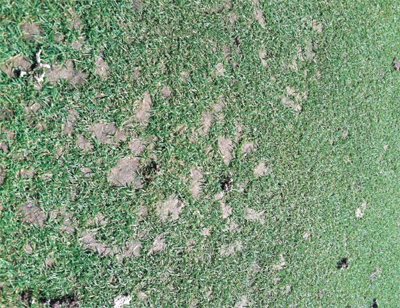
Figure 3. Casts of Amynthas hupeiensis muddy and smother the grass when smeared or compacted by tires or foot traffic.
Little is known about seasonal development of A. hupeiensis or where they overwinter. To clarify those points, we used a golf cup-cutter to collect monthly samples of worms from the same heavily infested sand-based putting green for a year. There was much overlap of life stages, but adults tended to predominate in May and June and again in autumn, whereas juveniles were more abundant in summer. We observed no casting and found no active life stages in sand-based greens in winter (December to February), but did find adults and juveniles in cores pulled from the native soil surrounds. Our samples and observations indicate that, on golf courses, A. hupeiensis overwinters in surrounds and begins encroaching into greens in early spring, with casts concentrated just inside the collar in March, followed by more uniform infestation of whole greens by mid-spring. The worm is highly mobile, and large numbers were seen crawling on the surface of greens, especially after rains (Figure 1).
Controlling green stinkworms and their casts
We did four trials over two growing seasons to evaluate insecticides and other products for effectiveness in reducing casting by Amynthas hupeiensis. Three of the trials were conducted on in-play sand-based creeping bentgrass putting greens, and one was on a creeping bentgrass croquet court. Details of each trial are reported elsewhere (9).
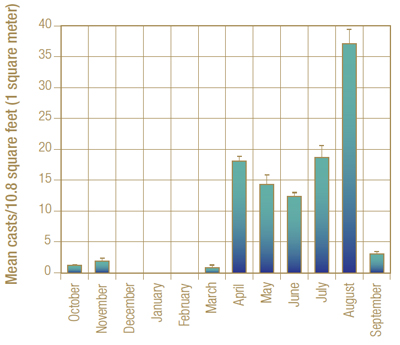
Figure 4. Seasonal pattern of casting by Amynthas hupeiensis based on monthly cast counts in four 50-foot-long (15-meter-long), 1-foot-wide (30-cm-wide) transects across a sand-based putting green, October 2013 to October 2014. There were no casts in December, January or February.
The most important finding was that a single application (on May 22) of one or the other of the neonicotinoid-pyrethroid combination insecticides Aloft GCSC (clothianidin + bifenthrin) or Triple Crown (zeta-permethrin + bifenthrin + imidacloprid) applied at their label rates for ant control on putting greens (0.54 or 0.8 fluid ounce product/1,000 square feet, respectively) gave nearly 100% control of casting for at least eight weeks after application (Figure 6). Aloft was also tested at half the label rate (0.27 fluid ounce/1,000 square feet), which was as effective as the full label rate. All applications were followed immediately by about 2⁄3 inch (1.7 cm) of irrigation from the golf course sprinkler system. In additional trials, Aloft or Triple Crown gave rapid, nearly complete reduction in casting.
During the same week in late May when we treated the trial shown in Figure 6, the superintendent at the cooperating course treated six other whole greens with Aloft at the full label rate. Those greens had been almost unplayable because of the abundance of A. hupeiensis casts. That single application essentially eliminated casting for the remainder of the growing season (Figure 7), allowing cast-free maintenance and play for the first summer since A. hupeiensis had been noticed on the course about five years earlier.
We also tested several organic options for controlling A. hupeiensis. Early Bird organic fertilizer (Ocean Organics) contains natural saponins (soaps) that irritate and expel earthworms, causing them to surface, desiccate and die. The product can significantly suppress casting by Aporrectodea, which are typically the most common earthworms in temperate-zone fairways and soil-based greens (6,7). Although Early Bird gave 85% or better suppression of A. hupeiensis casts at one day after treatment, casting on those plots had resumed by seven days after treatment, probably because of re-infestation by worms crawling from nearby untreated portions of the greens (9). The saponins in Early Bird, which disrupt the mucus coatings on earthworms, work mainly on contact and probably have little or no residual activity (6). A product containing soluble sulfur (15%) plus surfactant (CastClear, The Lawn Co.) and one with concentrated natural pyrethrins (6%) + piperonyl butoxide (ExciteR, Prentiss) failed to suppress A. hupeiensis casting in short-term trials (9).
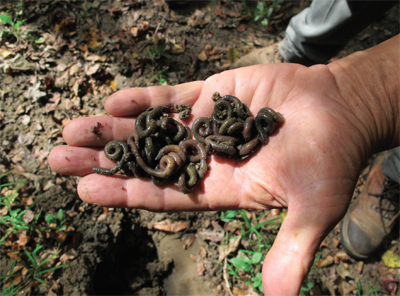
|
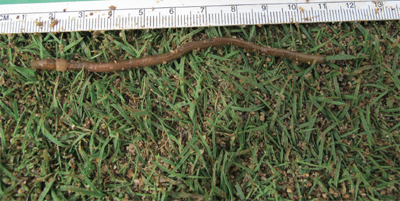
|
|
Figure 5. Top: A number of Amynthas hupeiensis individuals were found in a single shovelful of silty sand from a riverbank about 3 miles (5 km) from the main golf course study site. Bottom: An adult A. hupeiensis (note fully developed clitellum behind head) about 4.75 inches (12 cm) long.
|
How does an invasive Asian earthworm end up on golf courses?
Asian earthworms, including Amynthas hupeiensis, have become established around the banks of lakes and rivers as the result of anglers discarding bait (3), and they may also be transported as cocoons in compost, mulch or soil (1). Amynthas reproduce asexually — offspring develop from unfertilized eggs enclosed in tiny, lemon-shaped cocoons no bigger than a grain of rice. The eggs can remain dormant for months or even years before hatching if environmental conditions are not suitable. Inadvertent transport of even a single cocoon could potentially establish a population (3).
The superintendent and grounds crew members at the golf course where most of this research was done were adamant that their A. hupeiensis problems started during the year after course renovations were made with crude (non-sterilized) sand dredged from banks of the Ohio River. Sand from the same supplier was anecdotally linked to several other Kentucky courses where we found the pest (authors’ conversations with superintendents). Amynthas hupeiensis is established along banks of the Ohio and Kentucky rivers, as well as those of other large and smaller rivers throughout the central U.S. (4). The species, referred to by anglers as “green stinkworm,” “green riverworm” or “green worm,” is a popular catfish bait, and where and how to dig it is discussed on websites devoted to that pastime.
We visited a riverbank favored by catfish anglers on a medium-sized river — about 1.2 miles from the aforementioned infested course — where turning over a few shovelfuls of river sand and silt yielded large numbers of A. hupeiensis (Figure 5). Although finding the same Asian earthworm in sand along riverbanks and on greens and surrounds of a golf course to which such sand had been transported does not prove an association, it suggests a probable scenario by which A. hupeiensis may be introduced to golf courses in crude river sand. It might also be introduced as cocoons or active life stages in compost or mulch (1), by anglers dumping bait around golf course lakes or ponds, or in irrigation water drawn from such sources.
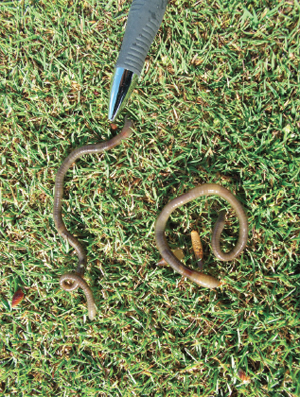
Two juvenile A. hupeiensis.
Presently, no pesticides are labeled for controlling earthworms in North America (8). Given the extensive damage that Amynthas species are capable of causing to forest ecosystems, gardens and golf courses, and given the ease with which they may be spread, we hope that regulatory agencies will recognize the need for registered pesticides to help manage these invasive pests, at least in horticultural settings. In the meantime, superintendents should be able to manage green stinkworms with either of the pre-mix insecticide formulations (Aloft or Triple Crown) we evaluated. Neither product is registered for earthworm control, but both are labeled for use against nuisance ants on golf course putting greens. When applied at label rates for ants, they can be expected to provide, as a side effect, at least two months’ control of casting by A. hupeiensis.
Funding
We thank the O.J. Noer Turfgrass Research Foundation for a grant that helped support this research.
Acknowledgments
We thank the staff of Beechfork Golf Club in Clay City, Ky., for their cooperation.
Literature cited
- Bellitürk, K., J.H. Görres, J. Kunkle and R.D.S. Melnichuk. 2015. Can commercial mulches be reservoirs of invasive earthworms? Promotion of ligninolytic enzyme activity and survival of Amynthas agrestis (Goto and Hatai, 1899). Applied Soil Ecology 87:27-31.
- Greiner, H.G., D.R. Kashian and S.D. Tiegs. 2012. Impacts of invasive Asian (Amynthas hilgendorfi) and European (Lumbricus rubellus) earthworms in a North American temperate deciduous forest.
- Hendrix, P.F., M.A. Callaham Jr., J.M. Drake, C.Y. Huang, S.M. James, B.A. Snyder and W. Zhang. 2008. Pandora’s box contained bait: The global problem of introduced earthworms. Annual Review of Ecology and Systematics 39:593-613.
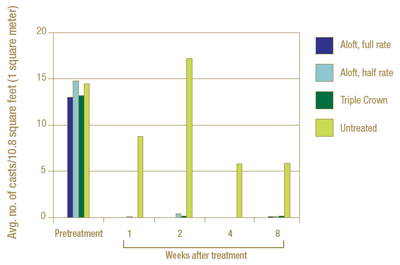
Figure 6. Season-long control of Amynthas hupeiensis casts on sand-based putting greens. Treatments were applied on May 22, 2014, and were watered in with about 2⁄3 inch of irrigation.
- James, S.W., and P.F. Hendrix. 2004. Invasion of exotic earthworms into North America and other regions. Pages 75-88 in C.A. Edwards, ed. Earthworm ecology. 2nd ed. CRC Press, Boca Raton, Fla.
- Maier, R.M., and D.A. Potter. 2005. Factors affecting distribution of the mound-building turfgrass ant Lasius neoniger (Hymenoptera: Formicidae) and implications for management of golf course putting greens. Journal of Economic Entomology 98:891-898.
- Potter, D.A., C.T. Redmond, K.M. Meepagala and D.W. Williams. 2010. Managing earthworm casts (Oligochaeta: Lumbricidae) in turfgrass using a natural byproduct of tea oil (Camellia sp.) manufacture. Pest Management Science 66:439-446.
- Potter, D.A., C.T. Redmond and D.W. Williams. 2011. The worm turns: Earthworm cast reduction on golf courses. Golf Course Management 79(9):86-96.
- Potter, D.A., C.T. Redmond and D.W. Williams. 2013. Managing excessive earthworm casting on golf courses and sport fields. International Turfgrass Society Research Journal 12:347-355.
- Redmond, C.T., A. Saeed and D.A. Potter. 2016. Seasonal biology of the invasive green stinkworm Amynthas hupeiensis and control of its casts on golf course putting greens. Crop, Forage & Turfgrass Management 2016 (2): doi:10.2134/cftm2016.0006
- Schread, J.C. 1948. The tropical earthworm. USGA Journal (Autumn) 12-13.
- Schread, J.C. 1952. Habits and control of the Oriental earthworm. Connecticut Agricultural Experiment Station Bulletin 556, New Haven, Conn.
Daniel A. Potter is a professor and Carl T. Redmond is a research scientist in the Department of Entomology at the University of Kentucky-Lexington. Abiya Saeed was a research technician in the Department of Entomology at the University of Kentucky-Lexington and is currently consumer horticulture program instructor and master gardener coordinator at Michigan State University Extension in Genesee County, Mich.